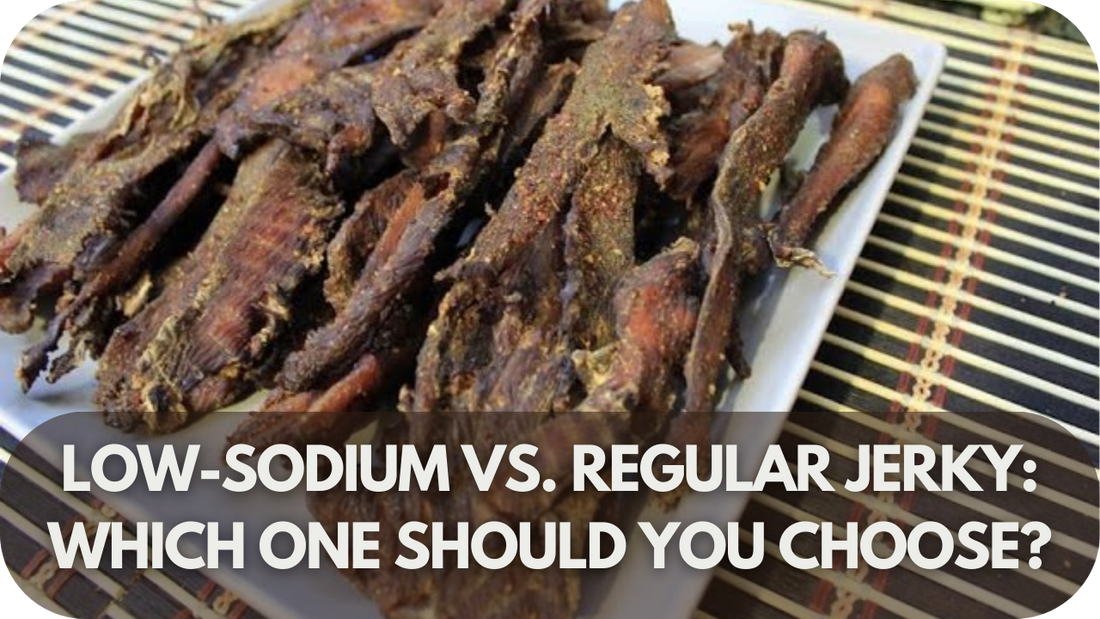
Low-Sodium vs. Regular Jerky: Which One Should You Choose?
Share
Jerky is a tasty, high-protein snack, but should you choose low-sodium or regular? Low-sodium jerky supports heart health and reduces bloating, while regular jerky delivers the bold, savoury flavour many love. However, sodium levels can impact overall well-being, especially for those watching their salt intake.
Does low sodium mean less taste? Is regular jerky too high in salt for daily consumption? This article breaks down the key differences, including flavour, nutrition, and health effects, to help you choose your diet and lifestyle best. Which one suits you best?
What Is Low-Sodium Jerky?
Low-sodium jerky is a healthier version of traditional jerky, made with less salt. It is perfect for those watching their sodium intake due to health reasons, such as high blood pressure or heart disease.
Regular jerky is often packed with salt to enhance flavour and preserve the meat, but low-sodium options use less salt while keeping the same great taste.
Instead of relying on salt, low-sodium jerky gets its flavour from natural herbs, spices, and alternative seasonings. Some brands also use lower-sodium soy sauce or vinegar to maintain the jerky’s signature savoury taste.
This type of jerky can still last a long time, thanks to other preservation methods like air-drying or vacuum sealing. However, it may have a slightly different texture or taste compared to traditional jerky.
What Is Regular Jerky?

Regular jerky is the classic, savoury snack loved for its rich flavour and long shelf life. Made from dried and seasoned meat, it is packed with protein and perfect for on-the-go eating.
Salt is a key ingredient in regular jerky. It enhances the taste, preserves the meat, and keeps bacteria away. Many brands also use soy sauce, Worcestershire sauce, or other salty seasonings to add depth to the flavour.
This type of jerky often has a bold, smoky, or spicy taste, depending on the recipe. The texture can be chewy or slightly tender, depending on how it is dried.
Because of its high salt content, regular jerky lasts a long time without refrigeration, making it an excellent snack for travel, hiking, or busy days.
But while regular jerky is delicious, it may not be the best choice for those watching their sodium intake.
Nutritional Differences Between Low-Sodium and Regular Jerky
The biggest difference between low-sodium and regular jerky is the salt content. Regular jerky contains high sodium, which helps with flavour and preservation.
A single serving can have 300–600 mg of sodium or more, which is a large part of the daily limit for some people. Low-sodium jerky, on the other hand, reduces the salt while keeping the protein and flavour. Some brands cut sodium by 30–50% or more.
Both types of jerky are high in protein, making them great for energy and muscle growth. They also contain essential nutrients like iron and B vitamins. However, regular jerky may have more sodium-heavy ingredients like soy sauce or seasoning blends.
Low-sodium jerky is often better for heart health and blood pressure, while regular jerky may be a better choice for those who need extra electrolytes, like athletes or hikers.
Health Benefits and Concerns

Is jerky a healthy snack or a salty indulgence? While both low-sodium and regular jerky offer nutritional benefits, they also come with a few concerns. Here’s a breakdown to help you weigh the pros and cons.
Health Benefits
- High in Protein – Both types are excellent protein sources, supporting muscle growth, satiety, and recovery.
- Rich in Essential Nutrients – Packed with iron, zinc, and B vitamins, which boost metabolism and immune function.
- Low in Carbs – A great option for low-carb or keto diets, making it ideal for those managing blood sugar levels.
- Convenient and Portable – A nutrient-dense, on-the-go snack perfect for busy lifestyles, hiking, or post-workout refuelling.
- Low-Sodium Jerky Benefits – Supports heart health, reduces bloating, and minimises water retention.
- Regular Jerky Benefits – Higher sodium content helps retain electrolytes, making it a great choice for athletes or outdoor adventurers.
Potential Concerns
- Sodium Intake – Regular jerky contains high salt levels, which can contribute to high blood pressure and fluid retention.
- Preservatives & Additives – Some brands use nitrates, MSG, or excessive sugar, which may not align with clean-eating preferences.
- Digestive Issues – Excess sodium and certain spices may cause bloating or discomfort, particularly for sensitive stomachs.
- Dehydration Risk – High-sodium jerky can lead to dehydration, especially when consumed without enough water.
Does Low-Sodium Jerky Taste Different?

low-sodium jerky tastes different, but that doesn’t mean it’s less enjoyable. Regular jerky gets much of its bold, savoury flavour from salt, which enhances the taste and brings out the natural meatiness. Low-sodium jerky may have a milder or slightly different flavour profile with less salt.
To make up for the lower salt content, brands often use herbs, spices, vinegar, or lower-sodium soy sauce to add depth and richness. Depending on the seasoning blend, some types may taste a little sweeter, smokier, or tangier. The texture is usually the same—chewy and satisfying—but some people notice a slight difference in how the flavours develop.
If you’re used to regular jerky, low-sodium versions might take a little getting used to. But for many, the reduced salt allows other flavours to shine, making it a tasty and healthier alternative.
Who Should Choose Low-Sodium Jerky?

Anyone looking to reduce their salt intake without giving up a tasty, high-protein snack should consider low-sodium jerky. People with high blood pressure, heart disease, or kidney concerns must watch their sodium levels, as too much salt can cause water retention, bloating, and increased blood pressure.
Athletes and fitness enthusiasts may also benefit from a lower-sodium option. While protein is essential for muscle recovery, excess salt can lead to dehydration, especially after intense workouts. Low-sodium jerky provides the protein boost without the extra sodium.
Even those without health concerns might prefer a jerky that lets the natural flavours shine. The taste of the meat, spices, and seasonings becomes more noticeable with less salt, creating a different but enjoyable eating experience.
Who Should Choose Regular Jerky?

Fans of rich, savoury flavours and a traditional jerky experience may prefer regular jerky. With its higher salt content, it delivers a bold taste while also helping to preserve the meat for a longer shelf life. This makes it a great choice for those who want a snack that lasts without refrigeration.
Athletes, hikers, and travellers often choose regular jerky for its high protein and sodium content. The extra salt helps replenish electrolytes lost through sweat, making it a useful snack for intense physical activity. Its long-lasting nature also makes it ideal for road trips, camping, or emergency food supplies.
People without dietary sodium restrictions may have no reason to switch. If you enjoy the classic jerky taste and don’t need to limit your salt intake, regular jerky can be part of a balanced diet when eaten in moderation.
Making the Right Choice: Factors to Consider
Health, lifestyle, and nutrition all play a role in selecting low-sodium or regular jerky. Understanding these factors ensures you make the best choice for your dietary needs and preferences.
1. Health Considerations
Your health should be the first factor when choosing between low-sodium and regular jerky. Reducing sodium intake is important if you have high blood pressure, heart disease, or kidney concerns.
Too much salt can cause bloating, dehydration, and long-term health issues. Low-sodium jerky offers a way to enjoy jerky without the added risks.
However, if you have no health restrictions and eat salt in moderation, regular jerky may not be a concern. Always check nutrition labels to ensure the sodium content meets your dietary needs.
2. Lifestyle Factors
How and when you eat jerky also matters. Regular jerky lasts longer and is ideal for travel, camping, and emergency food storage.
Its higher sodium content helps preserve the meat and prevents spoilage. Low-sodium jerky, while still convenient, may have a shorter shelf life and need better storage.
If you’re an athlete or spend long hours outdoors, regular jerky helps replace lost electrolytes. But if you eat jerky casually or want a lighter snack, low-sodium jerky could be a better fit.
3. Taste Preference

Flavour is key when picking between low-sodium and regular jerky. Regular jerky has a stronger, saltier taste that enhances the seasoning and meat.
The salt brings out umami flavours, giving it a richer profile. Low-sodium jerky, however, relies on spices, herbs, and natural ingredients for flavour. Some people prefer its milder, more balanced taste, while others miss the saltiness.
Regular jerky might be your top choice if you enjoy bold, savoury snacks. But if you like subtle, natural flavours, low-sodium jerky is worth trying.
4. Shelf Life and Storage
Sodium plays a key role in food preservation. Regular jerky, with its high salt content, stays fresh longer and can be stored without refrigeration.
This makes it great for stocking up or taking on long trips. Low-sodium jerky, while still shelf-stable, may not last as long. It often requires airtight storage and may need to be eaten sooner.
Regular jerky is the better option if you’re looking for a long-lasting snack. For everyday snacking, low-sodium jerky works well if properly stored.
5. Dietary Needs
Different diets call for different sodium levels. Low-sodium jerky is the better choice if you’re following a heart-healthy, low-sodium, or clean-eating diet. It helps reduce salt intake while still providing protein.
For those who need extra sodium, like endurance athletes, regular jerky may be more beneficial. Salt helps retain water and prevent muscle cramps.
Conclusion
Choosing between low-sodium and regular jerky depends on your health, lifestyle, and taste preferences. Low-sodium jerky is ideal for reducing salt intake, while regular jerky offers a bold, savoury taste.
Consider your dietary needs and flavour preferences before making a choice. Try both options today and find the jerky that suits you best!

